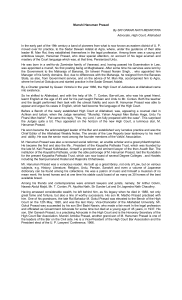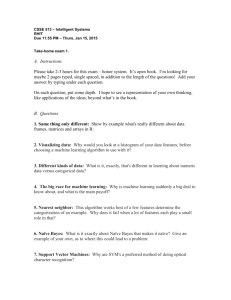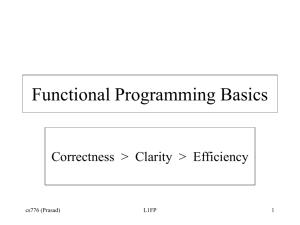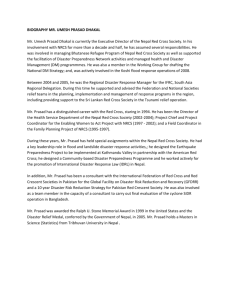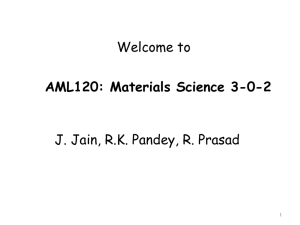CS276B Text Information Retrieval, Mining, and Exploitation
advertisement
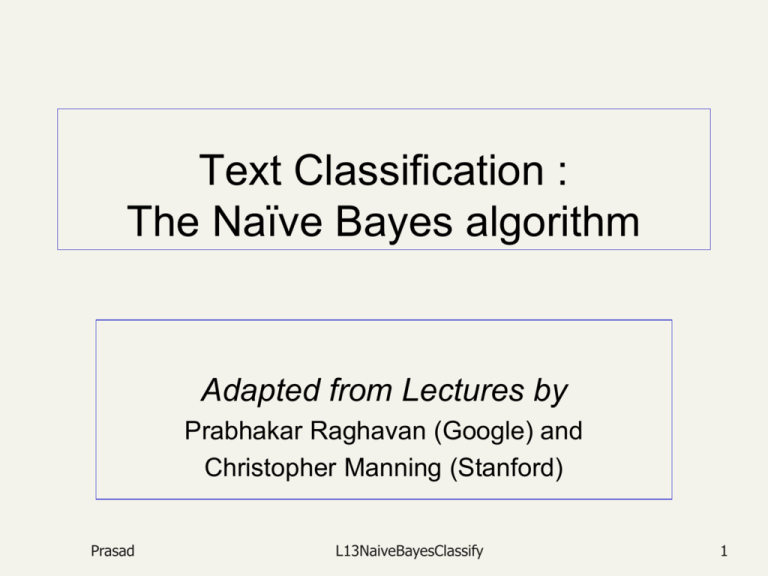
Text Classification :
The Naïve Bayes algorithm
Adapted from Lectures by
Prabhakar Raghavan (Google) and
Christopher Manning (Stanford)
Prasad
L13NaiveBayesClassify
1
Relevance feedback revisited
In relevance feedback, the user marks a number of
documents as relevant/nonrelevant, that can be used
to improve search results.
Suppose we just tried to learn a filter for nonrelevant
documents
This is an instance of a text classification problem:
Two “classes”: relevant, nonrelevant
For each document, decide whether it is relevant or
nonrelevant
The notion of classification is very general and has
many applications within and beyond IR.
Prasad
L13NaiveBayesClassify
2
Standing queries
The path from information retrieval to text
classification:
You have an information need, say:
You want to rerun an appropriate query
periodically to find new news items on this topic
Unrest in the Niger delta region
I.e., it’s classification not ranking
Such queries are called standing queries
Prasad
Long used by “information professionals”
A modern mass instantiation is Google Alerts
L13NaiveBayesClassify
3
13.0
Spam filtering: Another text
classification task
From: "" <takworlld@hotmail.com>
Subject: real estate is the only way... gem oalvgkay
Anyone can buy real estate with no money down
Stop paying rent TODAY !
There is no need to spend hundreds or even thousands for similar courses
I am 22 years old and I have already purchased 6 properties using the
methods outlined in this truly INCREDIBLE ebook.
Change your life NOW !
=================================================
Click Below to order:
http://www.wholesaledaily.com/sales/nmd.htm
=================================================
4
13.0
Introduction to Information Retrieval
3
Text classification:
Naïve Bayes Text Classification
Today:
Introduction to Text Classification
Also widely known as “text categorization”.
Probabilistic Language Models
Naïve Bayes text classification
Prasad
Multinomial
Bernoulli
Feature Selection
L13NaiveBayesClassify
6
Introduction to Information Retrieval
Formal definition of Classification:
Training/Testing
Given:
A document space X
Documents are represented in this space –
typically some type of high-dimensional space.
A fixed set of classes C = {c1, c2, . . . , cJ}
The classes are human-defined for the needs of
an application (e.g., relevant vs. nonrelevant).
A training set D of labeled documents with each
labeled document <d, c> ∈ X × C
8
Introduction to Information Retrieval
(cont’d)
Using a learning method or learning algorithm, we
wish to learn a classifier ϒ that maps documents to
classes:
ϒ:X→C
Given: a description d ∈ X of a document
Determine: ϒ (d) ∈ C, that is, the class that is most
appropriate for d
9
Introduction to Information Retrieval
Topic classification
10
Document Classification
“planning
language
proof
intelligence”
Test
Data:
(AI)
(Programming)
(HCI)
Classes:
ML
Training
Data:
Prasad
learning
intelligence
algorithm
reinforcement
network...
Planning
Semantics
Garb.Coll.
planning
temporal
reasoning
plan
language...
programming
semantics
language
proof...
Multimedia
garbage
...
collection
memory
optimization
region...
(Note: in real life there is often a hierarchy, not
present in the above problem statement; and also,
you get papers on ML approaches to Garb. Coll.)
GUI
...
11
13.1
Introduction to Information Retrieval
Examples of how search engines use classification
Language identification (classes: English vs. French etc.)
The automatic detection of spam pages (spam vs.
nonspam)
Topic-specific or vertical search – restrict search to a
“vertical” like “related to health” (relevant to vertical vs.
not)
Standing queries (e.g., Google Alerts)
Sentiment detection: is a movie or product review
positive or negative (positive vs. negative)
The automatic detection of sexually explicit content
(sexually explicit vs. not)
13
Classification Methods (1)
Manual classification
Used by Yahoo! (originally; now downplayed),
Looksmart, about.com, ODP, PubMed
Very accurate when job is done by experts
Consistent when the problem size and team is
small
Difficult and expensive to scale
Prasad
Means we need automatic classification methods for big
problems
L13NaiveBayesClassify
14
13.0
Classification Methods (2)
Automatic document classification
Hand-coded rule-based systems
Used by CS dept’s spam filter, Reuters, CIA, etc.
Companies (Verity) provide “IDE” for writing such rules
Standing queries: Commercial systems have complex
query languages (everything in IR query languages +
accumulators)
Prasad
E.g., assign category if document contains a given boolean
combination of words
Accuracy is often very high if a rule has been carefully
refined over time by a subject expert
Building and maintaining these rules is expensive
L13NaiveBayesClassify
15
13.0
A Verity topic (a complex
classification rule)
Note:
maintenance issues
(author, etc.)
Hand-weighting of
terms
16
Classification Methods (3)
Supervised learning of a document-label
assignment function
Many systems partly rely on machine learning
(Autonomy, MSN, Verity, Enkata, Yahoo!, …)
k-Nearest Neighbors (simple, powerful)
Naive Bayes (simple, common method)
Support-vector machines (new, more powerful)
… plus many other methods
No free lunch: requires hand-classified training data
But data can be built up (and refined) by amateurs
Note that many commercial systems use a
mixture of methods
Prasad
L13NaiveBayesClassify
17
Recall a few probability basics
For events a and b:
Bayes’ Rule
p(a, b) = p(a Ç b) = p(a | b)p(b) = p(b | a)p(a)
Prior
p(b | a)p(a)
p(b | a)p(a)
p(a | b) =
=
p(b)
å p(b | x)p(x)
Posterior
Odds:
Prasad
x=a,a
p(a)
p(a)
O(a )
p(a ) 1 p(a)
19
13.2
Example of Diagnosis
p(disease | symptom)
=
p(symptom | disease)
*
p(disease) / p(symptom)
Prasad
L13NaiveBayesClassify
20
Quick Summary:
Conditioning illustrated using Venn diagram
P(red) > P(green)
P(green | blue) > P(red | blue)
Prasad
L13NaiveBayesClassify
21
Bayesian Methods
Learning and classification methods based on
probability theory.
Bayes theorem plays a critical role in probabilistic
learning and classification.
Build a generative model that approximates how
data is produced.
Uses prior probability of each category given no
information about an item.
Categorization produces a posterior probability
distribution over the possible categories given a
description of an item (and prior probabilities).
Prasad
L13NaiveBayesClassify
22
13.2
Introduction to Information Retrieval
The bag of words
representation
γ(
I love this movie! It's sweet,
but with satirical humor. The
dialogue is great and the
adventure scenes are fun… It
manages to be whimsical and
romantic while laughing at the
conventions of the fairy tale
genre. I would recommend it to
just about anyone. I've seen it
several times, and I'm always
happy to see it again whenever
I have a friend who hasn't seen
it yet.
)=c
Introduction to Information Retrieval
The bag of words
representation
γ(
great
love
2
2
recommend 1
laugh
happy
...
1
1
...
)=c
Overall Approach Summary
Bayesian (robustness due to qualitative nature)
multivariate Bernoulli (counts of
documents)
multinomial (counts of terms)
Simplifying assumption for
computational tractability
conditional independence
positional independence
Prasad
L13NaiveBayesClassify
25
Overall Approach Summary
Dealing with idiosyncracies of
training data
smoothening technique
avoiding underflow using log
Improving efficiency and
generalizability (noise reduction)
feature selection
Prasad
L13NaiveBayesClassify
26
Bayes’ Rule
P ( C , D ) P ( C | D ) P ( D ) P ( D | C ) P (C )
P (D | C )P (C )
P (C | D)
P (D)
Prasad
L13NaiveBayesClassify
27
Naive Bayes Classifiers
Task: Classify a new instance D based on a tuple of attribute
values D x1 , x2 ,, xn into one of the classes cj C
cMAP argmax P(c j | x1 , x2 ,, xn )
c j C
argmax
c j C
P( x1 , x2 ,, xn | c j ) P(c j )
P( x1 , x2 ,, xn )
argmax P( x1 , x2 ,, xn | c j ) P(c j )
c j C
MAP = Maximum Aposteriori Probability
Prasad
L13NaiveBayesClassify
28
Naïve Bayes Classifier:
Naïve Bayes Assumption
P(cj)
Can be estimated from the frequency of classes in
the training examples.
P(x1,x2,…,xn|cj)
O(|X|n•|C|) parameters
Could only be estimated if a very, very large
number of training examples was available.
Naïve Bayes Conditional Independence Assumption:
Assume that the probability of observing the
conjunction of attributes is equal to the product of the
individual probabilities P(xi|cj).
Prasad
L13NaiveBayesClassify
29
The Naïve Bayes Classifier
Flu
X1
runnynose
X2
sinus
X3
cough
X4
fever
X5
muscle-ache
Conditional Independence Assumption:
Features (term presence) are independent of
each other given the class:
P( X 1 ,, X 5 | C ) P( X 1 | C ) P( X 2 | C ) P( X 5 | C )
This model is appropriate for binary variables
Prasad
Multivariate Bernoulli model
30
13.3
Learning the Model
C
X1
X2
X4
X5
X6
First attempt: maximum likelihood estimates
simply use the frequencies in the data
Pˆ (c j )
Prasad
X3
Pˆ ( xi | c j )
N (C c j )
N
N ( X i xi , C c j )
N (C c j )
31
13.3
Introduction to Information Retrieval
The problem with maximum likelihood estimates: Zeros
P(China|d) ∝ P(China) ・ P(BEIJING|China) ・ P(AND|China)
・ P(TAIPEI|China) ・ P(JOIN|China) ・ P(WTO|China)
If WTO never occurs in class China in the train set:
33
Introduction to Information Retrieval
The problem with maximum likelihood estimates: Zeros
(cont)
If there were no occurrences of WTO in documents in class
China, we’d get a zero estimate:
→ We will get P(China|d) = 0 for any document that contains
WTO!
Zero probabilities cannot be conditioned away.
34
Smoothing to Avoid Overfitting
Pˆ ( xi | c j )
N ( X i xi , C c j ) 1
N (C c j ) k
# of values of Xi
Prasad
L13NaiveBayesClassify
35
Introduction to Information Retrieval
To avoid zeros: Add-one smoothing
Before:
Now: Add one to each count to avoid zeros:
B is the number of different words (in this case the size of the
vocabulary: |V | = M)
36
Stochastic Language Models
Models probability of generating strings (each
word in turn) in the language (commonly all
strings over ∑). E.g., unigram model
Model M
0.2
the
0.1
a
0.01
man
0.01
woman
0.03
said
0.02
likes
…Prasad
the
man
likes
the
woman
0.2
0.01
0.02
0.2
0.01
multiply
L13NaiveBayesClassify
P(s | M) = 0.00000008
13.2.1
Stochastic Language Models
Model probability of generating any string
Model M1
Model M2
0.2
the
0.2
the
0.01
class
0.0001 class
0.0001 sayst
0.03
0.0001 pleaseth
0.02
0.2
pleaseth 0.2
0.0001 yon
0.1
yon
0.0005 maiden
0.01
maiden
0.01
0.0001 woman
woman
sayst
the
class
pleaseth
0.01
0.0001
0.0001 0.02
yon
maiden
0.0001 0.0005
0.1
0.01
P(s|M2) > P(s|M1)
13.2.1
Unigram and higher-order models
P(
)
= P(
) P(
|
) P(
|
Unigram Language Models
P( ) P( ) P( ) P(
) P(
|
)
Easy.
Effective!
)
Bigram (generally, n-gram) Language Models
P( ) P( | ) P(
Other Language Models
) P(
|
)
Grammar-based models (PCFGs), etc.
Prasad
|
Probably not the first thing to try in IR
L13NaiveBayesClassify
40
13.2.1
Using Multinomial Naive Bayes Classifiers
to Classify Text: Basic method
Attributes are text positions, values are words.
cNB argmax P(c j ) P( xi | c j )
c jC
i
argmax P(c j ) P( x1 " our" | c j ) P( xn " text" | c j )
c jC
Still too many possibilities
Assume that classification is independent of the
positions of the words
Use same parameters for each position
Result is bag of words model (over tokens not types)
Prasad
L13NaiveBayesClassify
41
Underflow Prevention: log space
Multiplying lots of probabilities, which are between 0
and 1, can result in floating-point underflow.
Since log(xy) = log(x) + log(y), it is better to perform
all computations by summing logs of probabilities
rather than multiplying probabilities.
Class with highest final un-normalized log probability
score is still the most probable.
c NB argmax log P(c j )
c jC
log P( x | c )
i positions
i
j
Note that model is now just max of sum of weights…
Prasad
L13NaiveBayesClassify
42
Note: Two Models
Model 1: Multivariate Bernoulli
One feature Xw for each word in dictionary
Xw = true in document d if w appears in d
Naive Bayes assumption:
Given the document’s topic,
appearance of one word in the
document tells us nothing about
chances that another word appears
Prasad
L13NaiveBayesClassify
43
Two Models
Model 2: Multinomial = Class conditional unigram
One feature Xi for each word pos in document
Value of Xi is the word in position i
Naïve Bayes assumption:
feature’s values are all words in dictionary
Given the document’s topic, word in one position in the
document tells us nothing about words in other positions
Second assumption:
Word appearance does not depend on position
P( X i w | c) P( X j w | c)
for all positions i,j, word w, and class c
Prasad
44
Parameter estimation ( 2 approaches)
Multivariate Bernoulli model:
Pˆ ( X w t | c j )
fraction of documents of topic cj
in which word w appears
Multinomial model:
Pˆ ( X i w | c j )
fraction of times in which
word w appears
across all documents of topic cj
Can create a mega-document for topic j by concatenating all
documents on this topic
Use frequency of w in mega-document
Prasad
L13NaiveBayesClassify
45
Classification
Multinomial vs Multivariate Bernoulli?
Multinomial model is almost always more
effective in text applications!
Casual occurrence distinguished from emphatic
occurrence in a long document
See IIR sections 13.2 and 13.3 for worked
examples with each model
Prasad
L13NaiveBayesClassify
46
Quick Summary:
Conditioning illustrated using Venn diagram
P(red) > P(green)
P(green | blue) > P(red | blue)
Prasad
L13NaiveBayesClassify
47
Quick Summary: Learning Problem
Learn a (one-of, multi-class)
classifier by generalizing
(interpolating and extrapolating)
from a labeled training dataset to
be used on a test set with similar
distribution (representativeness)
Prasad
L13NaiveBayesClassify
48
Quick Summary: Naïve Bayes Approach
FOR TRACTABILITY use “Bag of Words”
model
Conditional Independence: No mutual
dependence among words (cf. phrases
such as San Francisco and Tahrir Square)
Positional Independence: No dependence
on the position of occurrence in a sentence
or paragraph (cf. articles and prepositions
such as “The …”, “ … of …”, “ …and”
and “ …at”.)
Prasad
L13NaiveBayesClassify
49
Quick Summary: Naïve Bayes Approach
FOR PRACTICALITY
Prasad
Use (Laplace) Smoothing: To overcome
problems with sparse/incomplete training
set
E.g.,
P(“Britain is a member of WTO” | UK) >> 0
in spite of the fact that
P(“WTO”|UK) ~ 0
L13NaiveBayesClassify
50
Quick Summary: Naïve Bayes Approach
FOR PRACTICALITY
Use Logarithms: To overcome underflow
problems caused by small numbers
Prasad
E.g., Loglikelihood(hello) = -4.27
E.g., Loglikelihood(dear) = -4.57
E.g., Loglikelihood(dolly) = -5.49
E.g., Loglikelihood(stem) = -4.76
E.g., Loglikelihood(hello dear) = -7.16
E.g., Loglikelihood(hello dolly) = -6.83
E.g., Loglikelihood(hello stem) = -10.33
L13NaiveBayesClassify
51
Quick Summary: Naïve Bayes Approach
ESTIMATING PROBABILITY
Multi-nominal Naïve Bayes Model: one count per
term for each term occurrence (cf. term frequency)
Multivariate Bernoulli Model: one count per term
for each document it occurs in (cf. document
frequency); Also takes into account nonoccurrence
FEATURE SELECTION
Prasad
2 statistic approach
Information-theoretic approach
L13NaiveBayesClassify
52
Introduction to Information Retrieval
Overall Approach
Estimate parameters from the training
corpus using add-one smoothing
For a new document, for each class,
compute sum of (i) log of prior and (ii) logs
of conditional probabilities of the terms
Assign the document to the class with the
largest score
53
Introduction to Information Retrieval
Naive Bayes: Training
54
Introduction to Information Retrieval
Naive Bayes: Testing
55
Introduction to Information Retrieval
Exercise
Estimate parameters of Naive Bayes classifier
Classify test document
56
Introduction to Information Retrieval
Example: Parameter estimates
The denominators are (8 + 6) and (3 + 6) because the lengths of
textc and
are 8 and 3, respectively, and because the constant
B is 6 as the vocabulary consists of six terms.
57
Introduction to Information Retrieval
Example: Classification
Thus, the classifier assigns the test document to c = China. The
reason for this classification decision is that the three occurrences
of the positive indicator CHINESE in d5 outweigh the occurrences
of the two negative indicators JAPAN and TOKYO.
58
Introduction to Information Retrieval
Time complexity of Naive Bayes
Lave: average length of a training doc, La: length of the test
doc, Ma: number of distinct terms in the test doc, training
set, V : vocabulary, set of classes
is the time it takes to compute all counts.
is the time it takes to compute the parameters
from the counts.
Generally:
Test time is also linear (in the length of the test document).
Thus: Naive Bayes is linear in the size of the training set
(training) and the test document (testing). This is optimal.
62
Introduction to Information Retrieval
Bernoulli: Training
63
Introduction to Information Retrieval
Bernoulli : Testing
64
Introduction to Information Retrieval
Exercise
Estimate parameters of Bernoulli classifier
Classify test document
65
Introduction to Information Retrieval
Example: Parameter estimates
The denominators are (3 + 2) and (1 + 2) because there are three
documents in c and one document in c , and because the constant
B is 2 as there are two cases to consider for each term, occurrence
and nonoccurrence. (No information is probability = 0.5.)
66
Introduction to Information Retrieval
Example: Classification
Thus, the classifier assigns the test document to c = not-China.
When looking only at binary occurrence and not at term frequency,
Japan and Tokyo are indicators for c (2/3 > 1/5) and the conditional
probabilities of Chinese for c and c are not different enough (4/5 vs.
2/3) to affect the classification decision.
67
Introduction to Information Retrieval
Why does Naive Bayes work?
Naive Bayes can work well even though conditional
independence assumptions are badly violated.
Example:
Classification is about predicting the correct class
and not about accurately estimating probabilities.
Correct estimation ⇒ accurate prediction.
But not vice versa!
70
Introduction to Information Retrieval
Naive Bayes is not so naive
Naive Naive Bayes has won some bakeoffs (e.g., KDD-CUP 97)
More robust to nonrelevant features than some more complex
learning methods
More robust to concept drift (changing of definition of class over
time) than some more complex learning methods
Better than methods like decision trees when we have many
equally important features
A good dependable baseline for text classification
Optimal if independence assumptions hold (never true for text, but
true for some domains)
Very fast
Low storage requirements
71
Feature Selection: Why?
Text collections have a large number of features
10,000 – 1,000,000 unique words … and more
Feature Selection
Makes using a particular classifier feasible
Reduces training time
Training time for some methods is quadratic or worse in the
number of features
Can improve generalization (performance)
Prasad
Some classifiers can’t deal with 100,000 of features
Eliminates noise features
Avoids overfitting
L13NaiveBayesClassify
72
13.5
Feature selection: how?
Two ideas:
Hypothesis testing statistics:
Information theory:
Are we confident that the value of one categorical
variable is associated with the value of another
Chi-square test (2)
How much information does the value of one categorical
variable give you about the value of another
Mutual information (MI)
They’re similar, but 2 measures confidence in association,
(based on available statistics), while MI measures extent of
association (assuming perfect knowledge of probabilities)
Prasad
L13NaiveBayesClassify
73
13.5
2 statistic (CHI)
2 test is used to test the independence of
two events, which for us is occurrence of a
term and occurrence of a class.
N.. = Observed Frequency
E.. = Expected frequency
74
13.5.2
Example from Reuters-RCV1
(term export class poultry)
Prasad
L13NaiveBayesClassify
75
Computing expected frequency
where, N = 49 + 141 + 27,652 + 774,106 = 801,948
Prasad
L13NaiveBayesClassify
76
Observed frequencies
and computed expected frequencies
where, N = 49 + 141 + 27,652 + 774,106 = 801,948
Prasad
L13NaiveBayesClassify
77
Interpretation of CHI-squared results
X2 value of 284 >> 10.83 implies that poultry and export
are dependent with 99.9% certainty, as the possibility of
them being independent is as remote as < 0.1%
Prasad
L13NaiveBayesClassify
78
Feature selection via Mutual
Information
In training set, choose k words which best
discriminate (give most info. on) the categories.
The Mutual Information between a word, class is:
p(ew , ec )
I (w, c ) p(ew , ec ) log
p(ew )p(ec )
e { 0,1} e { 0,1}
w
Prasad
c
For each word w and each category c
L13NaiveBayesClassify
81
13.5.1
Formula for computation (Equation 13.17)
N01 is number of documents that contain the term t (et = 1)
and are not in class c (ec = 0).
N1. is number of documents that contain the term t (et = 1).
Prasad
L13NaiveBayesClassify
82
Example
Prasad
L13NaiveBayesClassify
83
Feature selection via MI (contd.)
For each category we build a list of k most
discriminating terms.
For example (on 20 Newsgroups):
sci.electronics: circuit, voltage, amp, ground, copy,
battery, electronics, cooling, …
rec.autos: car, cars, engine, ford, dealer, mustang,
oil, collision, autos, tires, toyota, …
Greedy: does not account for correlations between
terms
Prasad
L13NaiveBayesClassify
84
Features with High MI scores
for 6 Reuters-RCV1 classes
Prasad
L13NaiveBayesClassify
85
Feature Selection
Mutual Information
Chi-square
Clear information-theoretic interpretation
May select rare uninformative terms
Statistical foundation
May select very slightly informative frequent terms
that are not very useful for classification
Just use the commonest terms?
Prasad
No particular foundation
In practice, this is often 90% as good
L13NaiveBayesClassify
86
Feature selection for NB :
Overall Significance
In general, feature selection is necessary for
multivariate Bernoulli NB.
Otherwise, you suffer from noise, multi-counting.
“Feature selection” really means something
different for multinomial NB. It means dictionary
truncation.
Prasad
This “feature selection” normally isn’t needed for
multinomial NB.
L13NaiveBayesClassify
87
SpamAssassin
Naïve Bayes has found a home in spam filtering
Paul Graham’s A Plan for Spam
A mutant with more mutant offspring...
Naive Bayes-like classifier with weird parameter
estimation
Widely used in spam filters
Classic Naive Bayes superior when appropriately used
According to David D. Lewis
But also many other things: black hole lists, etc.
Many email topic filters also use NB classifiers
Prasad
L13NaiveBayesClassify
93
